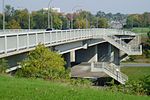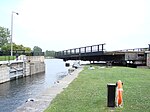Temple Israel (Ottawa)
Buildings and structures in OttawaCommons link is the pagenameJews and Judaism in OttawaReform synagogues in CanadaSynagogues in Ottawa
Temple Israel is the Jewish Reform Congregation of Ottawa. The community is dedicated to Torah, Tzedakah and Avodah. Temple Israel is the second largest congregation in Ottawa, with approximately 340 families. Temple Israel provides outreach to unaffiliated Jews, many social justice activities, interfaith dialogue between the congregation and Christians and Muslims, and supports a strong and vibrant supplementary religious school and youth group.
Excerpt from the Wikipedia article Temple Israel (Ottawa) (License: CC BY-SA 3.0, Authors).Temple Israel (Ottawa)
Prince Of Wales Drive, (Old) Ottawa River
Geographical coordinates (GPS) Address Nearby Places Show on map
Geographical coordinates (GPS)
| Latitude | Longitude |
|---|---|
| N 45.3716 ° | E -75.70634 ° |
Address
Temple Israel (Reform)
Prince Of Wales Drive 1301
K2C 1N2 (Old) Ottawa, River
Ontario, Canada
Open on Google Maps







